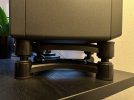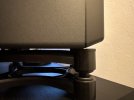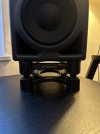In my experience the predictions are very close to the actual measurement (apart from the smoothing - the 100Hz dip is probably worse than it looks. Your own REW measurement provides a lot more info of course.This is just a visualization/prediction/wishful thinking of an EQed response, it's not a measurement and you can't tell anything from it. If you want to do measurements just use proper software
@morello777 This is a review thread of the KH150. Better start your own thread with your questions and more info about your room, speaker and listening positions and so on, if you want more help.



